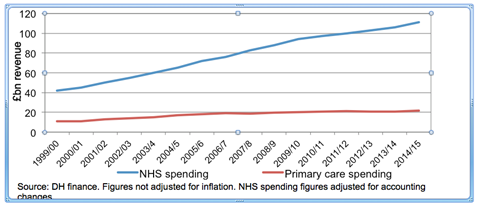There is huge potential to do things better in the NHS - and that is crucial if we are to achieve the care system envisaged in the Five Year Forward View, says Lord Prior
The Chancellor’s autumn statement was a good settlement for the NHS. It meets the funding requirement set out by Simon Stevens and other NHS leaders, and most importantly, as many chief executives and medical directors have since told me, it is a settlement that the NHS can live within.
Ahead of the spending review, many healthcare leaders urged the government to ensure the NHS got a frontloaded settlement. I’m pleased that we have achieved that, with the NHS receiving £3.8bn extra in 2016-17 – a significant down payment for the transformation needed to achieve the ambitions of the Five Year Forward View and make seven day services for patients a reality.
The changes envisaged within the Five Year Forward View are more fundamental and ambitious than any changes the system has witnessed since 1948. We must have a care system that can meet the demands of our population today, very different from some 70 years ago.
The Commonwealth Fund recently ranked the NHS the safest and most efficient healthcare system in the world. This really is a testament to staff
We must do this within the structures we currently have. Reorganisation would be a distraction. In fact, you need look no further than Manchester to see these structures working, and the early signs from the new models of care are encouraging.
By international standards, the NHS is lean and cost effective, spending about $3,200 per head on health, compared to $4,100 in France, $4,800 in Germany, $5,100 in the Netherlands and $8,700 in the US. The Commonwealth Fund recently ranked the NHS the safest and most efficient healthcare system in the world.
This really is a testament to staff across the NHS who work incredibly hard day-in, day-out, to deliver the excellent care that patients expect. However, there is immense potential for doing things better, and there are two main ways of ensuring we deliver on our promise of transformation.
One is to shift care from acute settings to out-of-hospital settings, reversing a trend we have witnessed since the early 2000s – of policy decisions driving activity and resources into acute providers, not primary and community care.

We have to improve the allocative efficiency of the system by providing the right care in the right place at the right time. This can be achieved through a mixture of prevention activities – targeting for instance, the rise of obesity and diabetes – and better commissioning of services as well as through new, innovative models of care provision, the vanguards.
Model hospital
It entails changing the way care is delivered, ensuring we develop a more integrated, place-based system. This is foreshadowed in the forward view:
“…there is broad consensus on what [the] future needs to be. It is a future that dissolves the classic divide, set almost in stone since 1948, between family doctors and hospitals, between physical and mental health, between health and social care, between prevention and treatment. One that no longer sees expertise locked into often outdated buildings, with services fragmented, patients having to visit multiple professionals for multiple appointments, endlessly repeating their details because they use separate paper records.
“One organised to support people with multiple health conditions, not just single diseases. A future that sees far more care delivered locally but with some services in specialist centres where that clearly produces better results.”
We also have to make better use of our central purchasing power to drive down procurement costs and get better value for the NHS
The second main way of delivering transformation is to improve productivity. Trusts around the country are already working with Lord Carter to identify variation and to describe the “model hospital”. This will lead to greater standardisation of best practice, improved workflow and rostering, and decreased dependency on agency staff. In the absence of a market, we need intelligent transparency to reveal variation and drive improvement.
To achieve the efficiencies at the scale required, we have two important levers. The NHS is one of the biggest land owners in England, with more than 28 million square metres of land. It must consider how better estate utilisation can support investment to deliver clinical priorities. We also have to make better use of our central purchasing power to drive down procurement costs and get better value for the NHS.
A new purpose
As the Chancellor himself made clear, we should also encourage more effective use of the existing partnerships between the NHS and independent providers to modernise buildings, equipment and services, especially where these partnerships support the upgrade of diagnostic capabilities and the development of new models of care.
Sir David Dalton’s recommendations on different organisational models including hospital chains make clear that embracing these ideas can drive forward standardisation, achieve operating efficiencies and reduce back office costs.
The transition from Monitor and Trust Development Authority to NHS Improvement under the leadership of Ed Smith and Jim Mackey is crucial to all this. It is not just about bringing together the two organisations, it’s creating a new organisation with a new purpose: to support providers to improve. This represents a fundamental change from a financial regulator, and I hope providers will see a real difference, and feel that NHS Improvement is here to help.
The government is committed to the NHS and the Five Year Forward View. It has made a substantial down payment. Now, we have to deliver.
Lord Prior minister for NHS productivity
Exclusive: Minister signals 'fundamental change' from financial regulation
- 1
- 2
 Currently reading
Currently readingLord Prior: Two ways to help deliver our promise of transformation




























1 Readers' comment